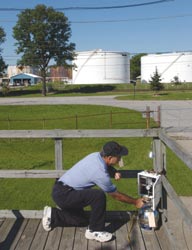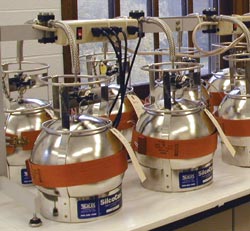![]() Current Issue
Current Issue
(Fall 2005)
Sniffing About: Air Pollution Docs Search for Toxins
Pure, stainless steel, glass-lined canisters are in the back of his vehicle, and John Metaxas is ready for his delivery run.
But the big round cans don't hold milk.

John Metaxas, coordinator of Speed's air quality laboratory, collects canisters containing air samples from various field sites as part of an ongoing west Louisville pollution study. After samples are removed, the canisters undergo rigorous cleaning in the lab (below left).
Metaxas is coordinator of the air quality laboratory in Ernst Hall at Speed School. Every 12 days, he logs 100 miles collecting and replacing specialized canisters that contain air samples from six monitoring sites—five in west Louisville and one in eastern Jefferson County.
It's part of a large-scale, community-wide effort to monitor the air in west Louisville and determine the health risks posed by pollution to residents.
Speed School's Metaxas and Mark Schreck, director of the materials testing labs in Speed's chemical engineering department, are playing a key role in the effort by collecting and analyzing the samples for toxic content.
"We're conducting ongoing monitoring using complex analytical methods," Schreck says. "We want to know what's going on in the air down there."
And so do some of the area's residents.
In response to complaints from citizens and local activists, a coalition was formed in 1996 to study air quality in the industrialized Rubbertown area of west Louisville. Taking the lead was the West Jefferson County Community Task Force, a community interest group of residents and industries.
Other study partners include the Jefferson County Air Pollution Control District, the Kentucky Division of Air Quality, the U.S. Environmental Protection Agency (EPA), the Kentucky Institute for the Environment and Sustainable Development (KIESD), the Kentucky Pollution Prevention Center and professor Harrell Hurst and associate professor Steven Myers in the pharmacology and toxicology department at U of L's medical school.
The EPA was involved in the project's early phase, sampling air at 12 county locations to establish testing parameters. Ongoing sampling is supported by state funds, while the task force is supported by government, industry, citizens and U of L.

Using air data collected by the study team in 2000 and 2001, Sciences International, a consulting group, issued a draft report this past summer predicting that 130 to 840 more cases of cancer per million people would develop in residents of the monitored areas over a 70-year exposure period.
According to the EPA, Jefferson County is one of the nation's 50 most-polluted counties in terms of toxic air emissions and has more air toxins than any other county in the southeast United States. In 2001, the latest year in which figures were released, 9.9 million pounds of pollutants spewed from smokestacks and other sources, ranking the county at Number 23 on the EPA's toxic release inventory.
KIESD director Russ Barnett says the chemicals of primary concern include the carcinogen 1,3-butadiene emitted by vehicles and industry, as well as chromium, carbon tetrachloride and acrylonitrile.
Schreck says the Speed School’s role in the study is not to interpret the broad meaning of the data, but to analyze it and report the findings to the county air pollution district.
"We’re strictly at the scientific level," he says. "We deal with the technical nuts and bolts."
The state-of-the-art air quality lab is the only university lab in the eastern United States set up to assess environmental air toxins, Barnett says.
Schreck and Metaxas have worked in chemical analysis for 35 years and 30 years, respectively.
The researchers say chemical sampling and analysis is very precise, capable of detecting gases at one part per billion in the air.
"It's complicated to take something as dilute as air and separate it into 78 different chemical compounds," Schreck says. "That's what the gas chromatograph does.
"We want to screen out things that are commonly found in the air: nitrogen, oxygen, methane, carbon dioxide, water vapor and so on," he adds.
"In the mass spectrometer, we can identify the compounds. It's like a fingerprint of the compound," Metaxas says.
"One problem of data analysis is repeatability," Metaxas adds. "We periodically compare our results with the EPA's lab, and they correlate well."
It's essential that the canisters be clean before being put back into the field, Metaxas says.
Once cleaned, the canisters are tested on a gas chromatograph to make sure there are no traces of the previous sample.
Even though a final report remains to be written, some Rubbertown industries recently submitted plans to Louisville Metro Mayor Jerry Abramson to reduce their pollution emissions.
In the meantime, Metaxas and Schreck will continue to gather samples and report their findings.
"We’re not sure what the final results will be, but we're confident that we'll continue to provide accurate air monitoring," Schreck says.
The team’s ongoing air monitoring results are posted at http://www.louisville.edu/org/wjcctf/.